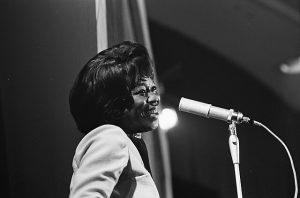Dexter Gordon Day
February 27, 1923 – April 25, 1990
A tribute to the beloved tenor saxophonist
Click here if you have a memory of this artist that you’d like to share
Note: Are you having trouble viewing the video? Click here to view it directly.
–
Click here to Support Jazz on the Tube
Tenor-saxophonist Dexter Gordon was born on February 27, 1923 in Los Angeles, California.
Gordon began playing clarinet when he was 13, switching to alto at 15 and tenor at 17.
He gained early experience playing with the Harlem Collegians, and the big bands of Lionel Hampton (1940-43), Fletcher Henderson and Louis Armstrong, being featured on a quintet date in 1943 with Nat King Cole.
A member of the Billy Eckstine big band in 1944 (featured trading off with Gene Ammons on “Blowin’ the Blues Away”), Gordon is considered the first tenor saxophonist to play bebop, recording “Blue ‘n Boogie” with Dizzy Gillespie in 1945.
Gordon, who made some important record dates for Savoy during the classic bebop era, spent most of the second half of the 1940s in Los Angeles where he was the star of many jam sessions, often opposite fellow tenors Wardell Gray (their recording of “The Chase” was popular) and Lucky Thompson.
Drug problems resulted in the 1950s being mostly a lost period for Gordon but he made the first of his three comebacks in 1960 when he signed with Blue Note and recorded a series of rewarding albums.
He spent the 1962-76 period living and working in Europe, playing in prime form and modernizing his style a bit (being influenced by John Coltrane who he had originally influenced) although his long absence resulted in him being almost forgotten in the U.S.
That changed when he made his second comeback in 1976, returning to the United States, playing in exciting form before large crowds and helping to fuel the comeback of acoustic jazz.
Gordon’s health declined in the early 1980s but then he made his third and final comeback, starring in the film Round Midnight and receiving an Academy Award nomination for best actor.
Dexter Gordon is featured on “Loose Walk” with a European rhythm section performing in Holland in 1964
-Scott Yanow
Click here if you have a memory of this artist that you’d like to share
–


